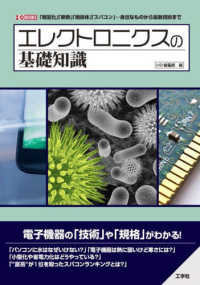Full Description
The Dutch painter and naturalist Otto Marseus van Schrieck became famous for an unusual iconography that mixed characteristics of landscape, animal painting, natural history illustration, and still life: the sottobosco paintings. These artworks, which he developed during his voyage to Italy around 1650, represent reptiles, amphibians, and insects in dark forests. To increase the realistic representations of lepidopterans, he pressed the wings of dead specimens onto the paintings to transfer their original colours. The technique of printing butterfly wings, named lepidochromy in this book, was already being used in the sixteenth century and has been documented as a means of conserving and classifying lepidopterans from the eighteenth through twentieth century.
With a strong focus on the techniques and materials involved in making butterfly imprints, this book introduces readers for the first time to the development, uses, and meanings of lepidochromy in the oeuvre of Otto Marseus van Schrieck at the crossroads of art and natural history.
Contents
INTRODUCTION
PART I | THE LEPIDOCHROMY TECHNIQUE
CHAPTER 1 | SEEING AND MAKING LEPIDOCHROMES
CHAPTER 2 | THE TERMINOLOGIES AND INHERITANCE OF LEPIDOCHROMY
PART II | OTTO MARSEUS VAN SCHRIECK AND THE LEPIDOCHROMY TECHNIQUE IN EARLY MODERN ART THEORIES AND NATURAL HISTORY
CHAPTER 3 | THE RELATIONSHIP BETWEEN LEPIDOCHROMY IN THE SOTTOBOSCHI AND SEVENTEENTH-CENTURY ART THEORIES
CHAPTER 4 | THE RELATIONSHIPS BETWEEN LEPIDOCHROMY IN THE SOTTOBOSCHI AND SEVENTEENTH-CENTURY NATURAL HISTORY
CONCLUSION
ANNEX I: TRANSCRIPTIONS OF RECIPES
BIBLIOGRAPHY
PLATES (COLOUR)








